Mushroom spotting at The Chevin, Otley
As I mentioned in my quick round-up yesterday, we found loads of mushrooms while walking at the Chevin, Otley with Lily-dog at the weekend – lots of different types and lots of each type. Unfortunately we didn’t have our mushroom identifying books with us so I had to make do with taking photos of some of them and attempting the identification later. The identifying is the most important thing for me at the moment – there are too many inedible and poisonous ones for me to want to try eating them until I’m more confident in my knowledge.
I’ve made some stabs at identification here – anyone got any feedback or better suggestions?
FYI, all the mushrooms here were found in the grass, but in a tree lined area so not exactly open grassland or deep dark forest. I didn’t pay that much attention to the trees but it was a largely deciduous area rather than the planted pine woods around there.
Mushroom 1
This was the first big one we saw. A light orange sombrero-shaped top with pinkish white gills underneath.
Clear gills, either sinuate or adnexed – I couldn’t get a good photo of it without picking it (which I didn’t want to do). Its hat is about 12cm in diameter, the stem about 1.5cm.
Ideas? I’ve discounted Field Blewit (this one’s cap is more orangey in colour without the violet in the stem). It’s far too big to be a Fairy Ring Champignon or a Meadow Wax Cap (gills too pale for that too). Not funnel-ish enough to be a false/Chanterelle. Possibly a Russula of some sort (a Common Yellow Russula (Russula ochroleuca) or a geranium-scented Russula(Russula fellea)? Didn’t smell it unfortunately so can’t use that as an identifier. It’s not quite as yellow as those though – more like tan brown.
Mushroom 2
I thought this was a baby version of Mushroom 1 when I first saw it but I’m not sure. The top was a more vivid yellow and glossier in appearance. I didn’t get any other photos of it so hard to identify – don’t know what the gills are like or the stem.
Ideas? Possibly a young yellow wax cap or egg yolk fungus?
Mushroom 3
This one was knocked over/picked by the time we got there, hence the full frontal gill pics, phwarr. A really rich brown speckled top – like slightly embossed animal print rather than shaggy. I would say the saucer was about 15cm in diameter, the stem about 3cm.
It didn’t look like it had been knocked over for that long but the brown specks on the gills are probably decay.
Ideas? The patterning is very much like a Parasol Mushroom (Macrolepiota procera) and they apparently get a chocolate-brown cap centre when they reach maturity – this is brown on more than the centre though.
Mushroom 4
There were hundreds of these little guys in one area – really hard to walk there without stepping on some. They were a orange-brown colour and wet-looking compared to the others.
This one’s cap was just over 1cm in diameter, the bigger ones probably just over 2cm. Not very much depth to the cap at all.
The decurrent (?) gills are pinkish-beige and very clearly distinguishable.
The stem of the one I picked dried out quite quickly. It was very spindly, perhaps 1.5mm/2mm in diameter. No ring.
Possibly the Deceiver (Laccaria Laccata)?
Any ideas what these mushrooms are? And/or any suggestions for good mushroom hunting reference books?!



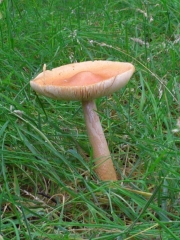
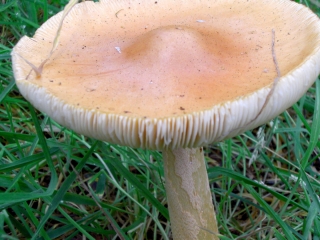
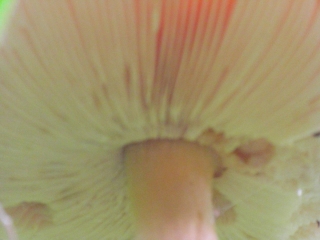
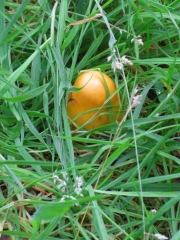
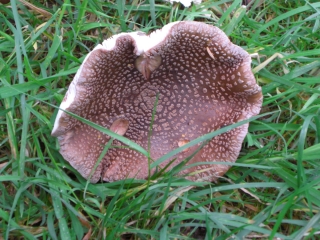
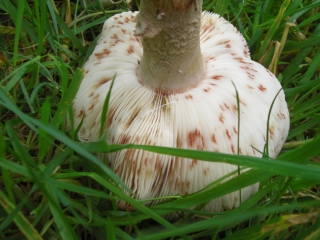
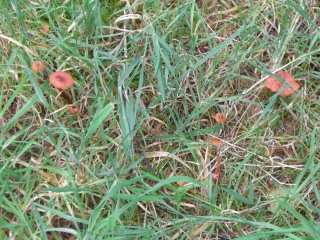
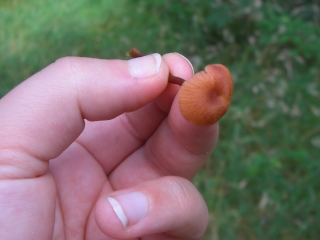
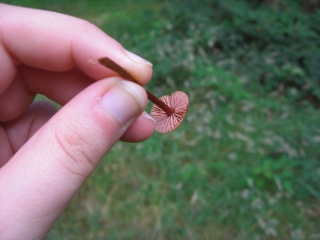
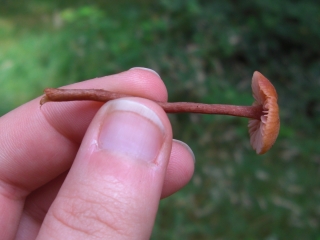
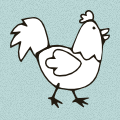

I Twitter-asked (twasked?) our friend Tim about his thoughts on the mushrooms:
I think the third was too big to be amanita pantherina but on the off chance that it is, it’s probably a really good idea we’re just identifying not nibbling at this stage!
I agree with you that the first mushroom pictured probably isn’t a blewit (otherwise known as clitocybe nuda or lepiista nuda), but not for the reason you mentioned. The lavender coloring fades as blewits mature (see http://www.mushroomexpert.com/clitocybe_nuda.html). While the coloring of yours is very similar to the blewits I’ve found, the little sombrero-type bump in the center of the cap isn’t present on my blewits. Their caps at the mature stage are flat or even indented or cup-like. Another difference is the stems, which are a lot thicker than the one in your picture. I suppose yours could be an intermediate stage, after the color changes and before the cap flattens out and the stem bulks up, but someone who knows a lot more about mushrooms than I do would have to say whether or not that’s the case.
Thanks for your input Deb! As I said above, it’s a really good job we’re still at the identifying not nibbling stage yet…. :)
One of the best test for edibility is to check the root of the mushroom. For instance, #3 could very well be a large pink blusher, which is delicious. If the root just grows out of the soil it’s edible, but it if grows out of a bulb that looks like an eggshell that cracked open and the mushroom grew out of it, it’s lethally poisonous it which case it would be what Louisa thinks it is.
This same test goes for a wild field mushroom and the infamous “cup of death”. The edible one doesn’t grow out of an eggshell like structure, but the poisonous one does.